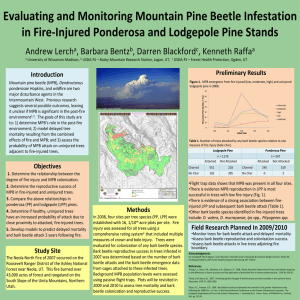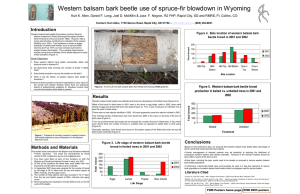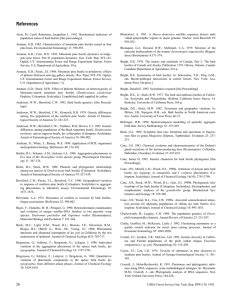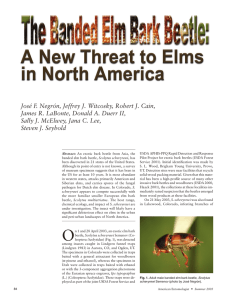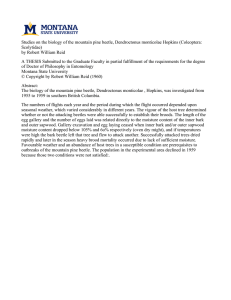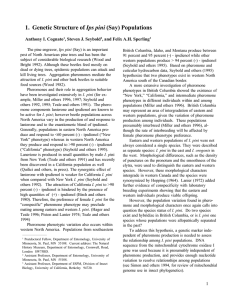O r t h o t o m i c...
advertisement
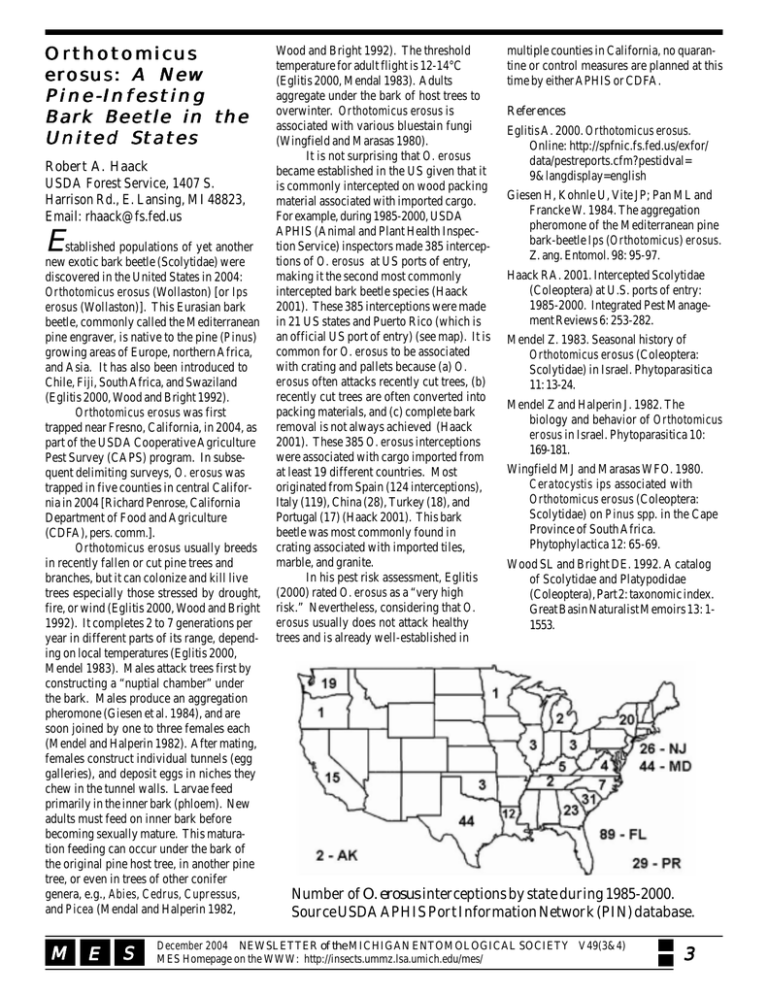
Orthotomicus erosus: A New Pine-Infesting Bark Beetle in the United States Robert A. Haack USDA Forest Service, 1407 S. Harrison Rd., E. Lansing, MI 48823, Email: rhaack@fs.fed.us E stablished populations of yet another new exotic bark beetle (Scolytidae) were discovered in the United States in 2004: Orthotomicus erosus (Wollaston) [or Ips erosus (Wollaston)]. This Eurasian bark beetle, commonly called the Mediterranean pine engraver, is native to the pine (Pinus) growing areas of Europe, northern Africa, and Asia. It has also been introduced to Chile, Fiji, South Africa, and Swaziland (Eglitis 2000, Wood and Bright 1992). Orthotomicus erosus was first trapped near Fresno, California, in 2004, as part of the USDA Cooperative Agriculture Pest Survey (CAPS) program. In subsequent delimiting surveys, O. erosus was trapped in five counties in central California in 2004 [Richard Penrose, California Department of Food and Agriculture (CDFA), pers. comm.]. Orthotomicus erosus usually breeds in recently fallen or cut pine trees and branches, but it can colonize and kill live trees especially those stressed by drought, fire, or wind (Eglitis 2000, Wood and Bright 1992). It completes 2 to 7 generations per year in different parts of its range, depending on local temperatures (Eglitis 2000, Mendel 1983). Males attack trees first by constructing a “nuptial chamber” under the bark. Males produce an aggregation pheromone (Giesen et al. 1984), and are soon joined by one to three females each (Mendel and Halperin 1982). After mating, females construct individual tunnels (egg galleries), and deposit eggs in niches they chew in the tunnel walls. Larvae feed primarily in the inner bark (phloem). New adults must feed on inner bark before becoming sexually mature. This maturation feeding can occur under the bark of the original pine host tree, in another pine tree, or even in trees of other conifer genera, e.g., Abies, Cedrus, Cupressus, and Picea (Mendal and Halperin 1982, M E S Wood and Bright 1992). The threshold temperature for adult flight is 12-14°C (Eglitis 2000, Mendal 1983). Adults aggregate under the bark of host trees to overwinter. Orthotomicus erosus is associated with various bluestain fungi (Wingfield and Marasas 1980). It is not surprising that O. erosus became established in the US given that it is commonly intercepted on wood packing material associated with imported cargo. For example, during 1985-2000, USDA APHIS (Animal and Plant Health Inspection Service) inspectors made 385 interceptions of O. erosus at US ports of entry, making it the second most commonly intercepted bark beetle species (Haack 2001). These 385 interceptions were made in 21 US states and Puerto Rico (which is an official US port of entry) (see map). It is common for O. erosus to be associated with crating and pallets because (a) O. erosus often attacks recently cut trees, (b) recently cut trees are often converted into packing materials, and (c) complete bark removal is not always achieved (Haack 2001). These 385 O. erosus interceptions were associated with cargo imported from at least 19 different countries. Most originated from Spain (124 interceptions), Italy (119), China (28), Turkey (18), and Portugal (17) (Haack 2001). This bark beetle was most commonly found in crating associated with imported tiles, marble, and granite. In his pest risk assessment, Eglitis (2000) rated O. erosus as a “very high risk.” Nevertheless, considering that O. erosus usually does not attack healthy trees and is already well-established in multiple counties in California, no quarantine or control measures are planned at this time by either APHIS or CDFA. References Eglitis A. 2000. Orthotomicus erosus. Online: http://spfnic.fs.fed.us/exfor/ data/pestreports.cfm?pestidval= 9&langdisplay=english Giesen H, Kohnle U, Vite JP; Pan ML and Francke W. 1984. The aggregation pheromone of the Mediterranean pine bark-beetle Ips (Orthotomicus) erosus. Z. ang. Entomol. 98: 95-97. Haack RA. 2001. Intercepted Scolytidae (Coleoptera) at U.S. ports of entry: 1985-2000. Integrated Pest Management Reviews 6: 253-282. Mendel Z. 1983. Seasonal history of Orthotomicus erosus (Coleoptera: Scolytidae) in Israel. Phytoparasitica 11: 13-24. Mendel Z and Halperin J. 1982. The biology and behavior of Orthotomicus erosus in Israel. Phytoparasitica 10: 169-181. Wingfield MJ and Marasas WFO. 1980. Ceratocystis ips associated with Orthotomicus erosus (Coleoptera: Scolytidae) on Pinus spp. in the Cape Province of South Africa. Phytophylactica 12: 65-69. Wood SL and Bright DE. 1992. A catalog of Scolytidae and Platypodidae (Coleoptera), Part 2: taxonomic index. Great Basin Naturalist Memoirs 13: 11553. Number of O. erosus interceptions by state during 1985-2000. Source USDA APHIS Port Information Network (PIN) database. December 2004 NEWSLETTER of the MICHIGAN ENTOMOLOGICAL SOCIETY V49(3&4) MES Homepage on the WWW: http://insects.ummz.lsa.umich.edu/mes/ 3




